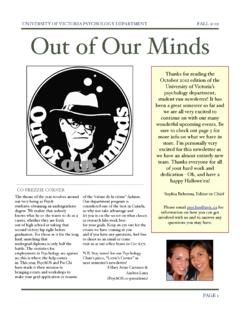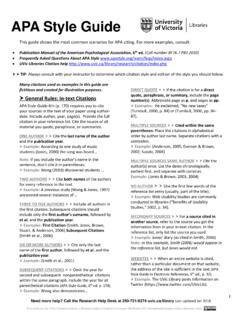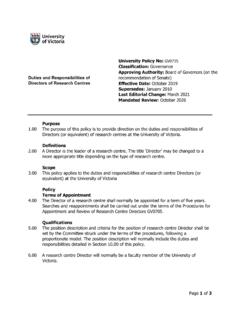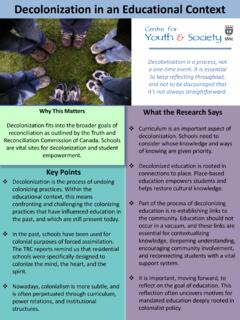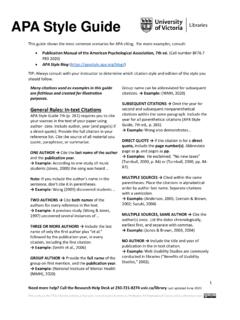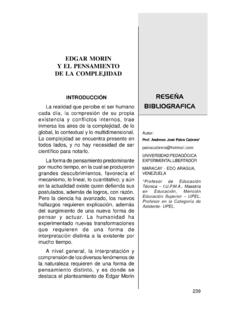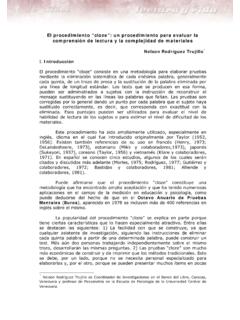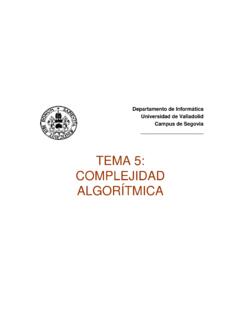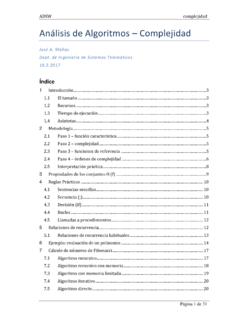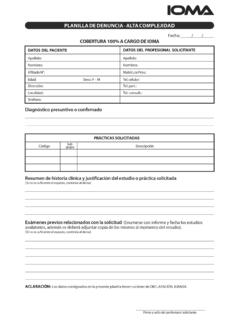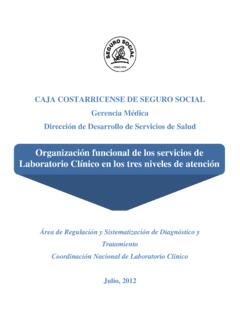Transcription of Complexity Science in Brief - University of Victoria
1 Complexity Science in Brief What is Complexity Science ? As an emerging approach to research, Complexity Science is a study of a system. It is not a single theory, but a collection of theories and conceptual tools from an array of disciplines (Benham-Hutchins & Clancy, 2010; Paley & Gail, 2011). For example, Complexity Science has been taken up in both natural ( mathematics) and social sciences (ecology), and has become increasingly popular in health care literature. Complexity Science is concerned with complex systems and problems that are are dynamic, unpredictable and multi-dimensional, consisting of a collection of interconnected relationships and parts. Unlike traditional cause and effect or linear thinking, Complexity Science is characterized by non-linearity.
2 According to Miles (2009), complex systems and problems require more than simplistic linear thinking. With a Complexity Science perspective, there is an appreciation of the complex, dynamic and interconnected relationships occurring within a complex system or problem. Considering the public and population health issues of obesity or chronic disease, there are a multitude of factors and relationships that contribute to the problem. Therefore, a public and population health intervention requires an approach that can account for the Complexity of the issue. In other words, public health professionals can be more effective if they understand the complex relationships that are occurring, rather than reducing problems to their smaller parts (Miles, 2009).
3 Why do I need to know it? Public health professionals deal with complex issues and scenarios daily (Miles, 2009). Also, the public health system itself has been described as a complex system, being dynamic, non-linear and comprised of independent but interconnected parts (Ross, 2009). Consequently, in order to improve public and population health, it is essential to understand the complex systems and problems involved (Leischow, Best, Trochim, Clark, Gallagher, Marcus & Matthews, 2008). In the words of Dekker (2010), Complexity theory says that if we really want to understand failure in complex systems, we need explore how things are related to each other and how they are connected to, configured in, and constrained by larger systems of pressures, constraints, and expectations (p.)
4 148). What advantages are there to my work? Einstein once said that insanity is doing the same thing over and over again and expecting different results. Instead of responding to public health issues and problems with a traditional simplistic or reductionist approach, Complexity Science provides an approach that acknowledges and embraces the challenge of Complexity (Holmes, Finegood, Riley & Best, 2011). If public health professionals embrace complex systems thinking, solutions can be designed and study to address the complex challenges that public health professionals continually face (Holmes et al., 2011). How do I do it? Though Complexity Science is an emerging approach, practical applications do exist and have been used.
5 As part of a meta-narrative synthesis, we developed a list of resources that have a practical application for public health professionals. The document is not exhaustive, but a beginning direction for applying Complexity Science methods. Please refer to the document titled, Complexity Science knowledge synthesis resources at , or email Complexity Science in Brief August, 2012 References Benham-Hutchins, M., & Clancy, T., (2010). Social networks as embedded complex adaptive systems. JONA, 40(9), 352-356. Dekker, S. (2010). We have Newton on a retainer: Reductionism when we need systems thinking. The Joint Commission Journal on Quality and Patient Safety, 36(4), 147-149.
6 Holmes, B. J., Finegood, D. T., Riley, B. L., & Best, A. (2011). Systems thinking in dissemination and implementation research. In R. Brownson, G. Colditz, & E. Proctor (Eds.), Dissemination and implementation research in health: translating Science to practice. Oxford: Oxford University Press. Leischow, S., Best, A., Trochim, W., Clark, P., Gallagher, R., Marcus, S., & Matthews, E, (2008). Systems thinking to improve the public s health. American Journal of Preventive, 35(2S), S196 S203. Miles, A. (2009). Complexity in medicine and healthcare: People and systems, theory and practice. Journal of Evaluation in Clinical Practice, 15, 409-410. Paley, J., & Gail, E. (2011).
7 Complexity theory as an approach to explanation in healthcare: A critical discussion. International Journal of Nursing Studies 48, 269 279. Ross, D. (2009). Process engineering: A necessary step to a better public health system. Information Knowledge Systems Management, 8, 299 309. This work is based on CIHR Knowledge Synthesis Grant. The relevance of Complexity concepts and systems thinking to public and population health intervention research: A metanarrative synthesis. (03/2011-03/2012). MacDonald, M., Jackson, B., Best, A., Bruce, E., Carroll, S., Hancock, T., Martin, W., & Riley, B.

